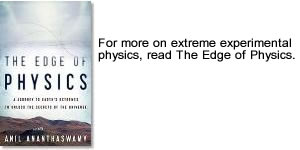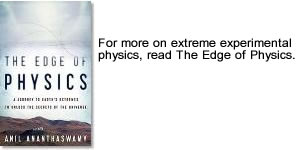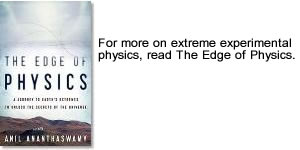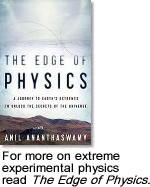Category — News
Einstein Goes Underground

Credit: NASA
EUROPEAN PHYSICISTS want to go underground to build a sensitive observatory capable of detecting gravitational waves that are thought be generated when black holes merge. The “Einstein Observatory” will 100 times more sensitive than existing detectors, and will likely be able to detect gravitational waves generated just after the Big Bang.
Gravitational waves are ripples in the fabric of spacetime and are predicted by Einstein’s General Relativity. The basic idea behind the detection of such waves is pretty simple. Build two extremely long tunnels and bounce lasers back and forth in these tunnels, which can each be a few kilometres long. A passing gravitational wave will distort spacetime and hence change the lengths of these tunnels ever-so-slightly. If the tunnels are at right angles, then they will distort differently, and consequently the lasers will have to travel different lengths. The interference pattern generated by the interaction of the lasers can reveal the passage of a gravitational wave.
Of course, building such a detector to “see” extremely faint movements of spacetime is another matter altogether. The first generation of gravitational wave detectors, such as VIRGO and LIGO have not seen any such wave, but have set limits on what physicists can expect in terms of the frequency and intensity of gravitational waves from cosmic collisions of black holes, for instance.
Already, the next generation of detectors, such as Advanced LIGO, are being built, and physicists hope to detect the first waves with these better machines.
The biggest hindrance to building sensitive gravitational wave detectors is noise, which can create a stochastic background against which it is very difficult to detect real waves.
The Einstein Observatory plans to reduce such noise, especially seismic noise, by going about 100-200 metres underground. The design calls for 3 interferometers, each tuned to different frequencies of gravitational waves, and each with interferometer arms about 10 kilometres long.
If such an instrument does get built, it’ll make gravitational wave astronomy as routine as other forms of astronomy (such as optical and radio).
Here’s the press release from interactions.org
May 19, 2023 No Comments
Super flares in the Crab nebula
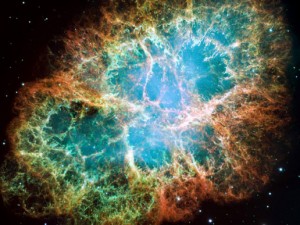
NASA’s FERMI gamma-ray space telescope has recorded the most violent outbursts from the Crab Nebula supernova remnant ever seen.
In the year 1054, light from a star that exploded about 6,500 years earlier reached Earth. Modern telescopes have given us an astounding view of the supernova remnant, in the form of the Crab Nebula. At the heart of the nebula is a neutron star that is rotating 30 times per second, sending periodic pulses of radiation towards Earth. The nebula is also a constant source of gamma-rays.
On April 12, FERMI detected gamma-ray flares that were 30 times more powerful than the average emissions from the nebula. Physicists think that a phenomenon called magnetic reconnection-in which the magnetic field lines near the neutron star cross and realign, leading to a release of extraordinary amounts of energy-is accelerating electrons to high energies. These electrons are then interacting with the magnetic field and emitting gamma-rays, which is what FERMI detected.
The most amazing fact that stands out from these observations is this: the region that is emitting these gamma rays is about the size of our solar system!
For more about these flares, see NASA’s press release.
May 16, 2023 No Comments
The Stunning Lagoon Nebula
THE GEMINI OBSERVATORY released a stunning photograph of the Lagoon Nebula, a stellar nursery about 5,000 light years away, which, if you may, puts in our own galactic neighbourhood.
Argentinean astronomers Julia Arias and Rodolfo Barbá captured the image using the Gemini South telescope atop Cerro Panchon in the Chilean Andes.
The photograph is a composite of images taken using different filters, some of them collecting light that would not be visible to the naked eye. So, if you were to look at the Lagoon Nebula using a small telescope, it would appear rather different. But you can find it using an amateur telescope, if you trained it in the direction of Sagittarius in the southern sky.
Here’s a link to a high-res JPEG.
More details can be found on the Gemini Observatory website.
May 5, 2023 No Comments
Gravity Probe B confirms Einstein’s Theories
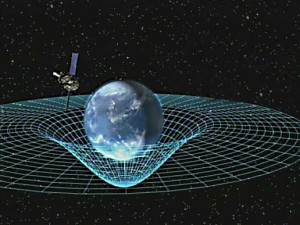
IT TOOK FIVE DECADES from conception to results, but finally NASA’s Gravity Probe B has confirmed two cherished predictions of Einstein’s General Theory of Relativity.
“It is wonderful to have completed this landmark experiment testing Einstein’s universe. Einstein survives!” said Professor Francis Everitt of Stanford University, principal investigator of Gravity Probe B.
Not that Einstein’s theory was in any real danger of being proven wrong in the local environment of the Earth, nonetheless this long-awaited confirmation is worth celebrating.
Gravity Probe B used impeccably-designed gyroscopes to put Einstein to the test. Newton’s theory of gravity predicts that the axis of a gyroscope spinning freely in space, without any other forces to disturb its motion, would continue pointing in the same direction forever. Einstein begged to differ. His theory predicts that the fabric of spacetime around Earth is being warped by Earth itself (the geodetic effect), plus the rotating Earth is also dragging along spactime (the frame dragging effect), both of which would perceptibly change the direction of a gyroscope.
Both effects have been tested and confirmed by Gravity Probe B. Now, those interested in testing Einstein’s General Relativity will likely set their sights on large-scale phenomena (which occur on cosmological scales) and begin testing them with increasing accuracy.
For more information see:
Lockheed Martin Press Release
NASA Press Release
May 4, 2023 No Comments
Likely remnant of black hole explosion seem by FERMI

Image: NASA
NASA’s FERMI satellite is seeing what appears to be the remains of a giant black hole that erupted millions of years ago. The structure-which shows up as two massive bubbles emitting gamma-rays-is at the centre of the Milky Way and spans an astounding 50,000 light years.
The image above (courtesy: NASA) shows the bubbles in full glory.
Doug Finkbeiner of the Harvard-Smithsonian Center for Astrophysics in Cambridge, Massachusetts, and his colleagues had to do some fancy signal processing to extract this image from the diffuse gamma-ray background that pervades the sky.
Finkbeiner is no stranger to such analysis. A few years ago, he identified something called the WMAP haze-a diffuse emission at the centre of the galaxy, which may be due to dark matter particles. He found the haze by subtracting from NASA’s WMAP data-which measured the cosmic microwave background-signals emanating from known sources in the galaxy, such as hot dust and synchrotron radiation from electrons spiralling around magnetic fields. After accounting for all known sources, including the cosmic microwave background, there was still some leftover emission, which came to be called the WMAP haze.
Now, he and his colleagues have used similar skills to remove the gamma-ray background creating by fast-moving particles interacting with light and interstellar gas. It also explains why other astronomers looking at the same data from NASA’s FERMI satellite did not see the giant bubbles.
See NASA’s press release for more details.
November 10, 2022 1 Comment
Living next door to Alice: closest you can get to a big bang

THE ALICE experiment at the Large Hadron Collider has seen the highest temperatures ever created in an experiment, according to a press release from the Science and Technology Facilities Council, UK. On 7 November, the LHC collided lead ions (instead of the usual protons against protons), and this produced what are referred to as mini big bangs: dense fireballs that have temperatures of about 10 trillion degrees.
At such temperatures and energies, the nuclei of atoms melt into a mix of their constituents: quarks and gluons. The fireball is known as a quark-gluon plasma.
The formation of the plasma is a key prediction of the extremely successful theory of quantum chromodynamics (QCD), which tells us that with increasing energy scales (or as we go back to earlier and earlier times in the universe’s history), the strength of strong interactions falls asymptotically to zero. This discovery of “asymptotic freedom” is what resulted in a Nobel Prize for David Politzer, Frank Wilczek and David Gross in 2004.
The quark-gluon plasma has been studied in detail at the Relativistic Heavy Ion Collider (RHIC) at Brookhaven, which smashes gold ions head-on. In Feb 2010, RHIC researchers reported the creation of a plasma that had temperatures of 4 trillion degrees C.
Now, with a 287 TeV beam (3.5 TeV x 82, the charge of lead ions), the LHC’s lead ions are colliding with an energy about 13.5 times greater than what has been achieved at RHIC. The resultant plasma fireballs will allow physicists using the 10,000-tonne ALICE to study the universe as it was about a millionth of a second after the big bang.
One can only wonder about what surprises are in store. At RHIC, the biggest surprise was that the quark-gluon plasma, instead of being a gas acts like a perfect liquid.
November 7, 2022 1 Comment
India’s giant neutrino observatory gets the nod

Site for the Indian Neutrino Observatory (credit: M V N Murthy)
THE INDIAN NEUTRINO OBSERVATORY received a big boost last week when the Ministry of Environment and Forests gave it formal approval.
The observatory will host a massive neutrino detector, which will include 50,000 tonnes of magnetised iron, making it the largest of its kind in the world. The largest magnet being used in physics experiments today is in the Compact Muon Solenoid (CMS) detector at CERN.
After almost half-a-century, Indian physicists will attempt to get back at the forefront of neutrino physics.
In the 1960s, India hosted one of the world’s first underground neutrino experiments. Called the Kolar Gold Fields neutrino experiment, it was built inside a 2316-metre-deep gold mine in Southern India. In 1965, the experiment became the first to detect atmospheric neutrinos. Here’s a report about the experiment from the CERN website.
Here is my New Scientist story with more details about the Indian Neutrino Observatory.
October 23, 2022 No Comments
Cosmic backlight shows up giant galaxy cluster
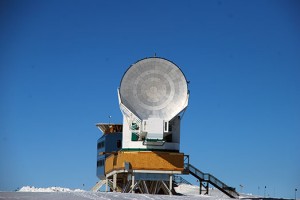
THE SOUTH POLE TELESCOPE has discovered the most massive cluster of galaxies yet seen at a distance of 7 billion light years.
The 10-meter SPT is an extremely sensitive radio telescope, designed to study the cosmic microwave background, the universe’s first light that was emitted when the cosmos was about 370,000 years old.
As the CMB travels towards us, it encounters mostly empty space. But occasionally, it’ll have to pass through a galaxy cluster, and this has the effect of reducing the temperautre of the CMB photons. It’s called the Sunayev-Zeldovich effect, after the scientists who predicted it in the 1970s.
It’s these cool spots in the CMB that the SPT is trying to find-and it did find one that led to the discovery of the massive cluster, which has a mass of 800 trillion suns.
What is amazing is that the cosmic microwave background, which is itself an extremely faint radiation, is now being used a cosmic back-light, shining at us from the early universe, before any large-scale structures had formed. Galaxy clusters show up as shadows-in a manner of speaking-against this back-light, helping us see the universe’s earliest giant structures which would be too faint for optical telescopes.
The above picture was taken when the SPT was still under construction (it doesn’t have the ground shield that will protect it from radiation reflected off the snow and ice). During my visit to the South Pole, I thought this telescope was one of the most beautiful I had seen through all my trips to write The Edge of Physics.
See here for press release from the Harvard Smithsonian Center for Astrophysics.
October 18, 2023 No Comments
Discoverer of Einstein’s Cross-John Huchra-dies unexpectedly
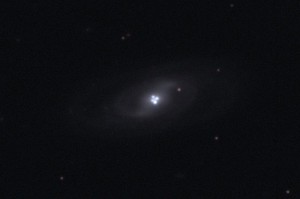
Celebrated astronomer and Harvard University professor John Huchra died unexpectedly on Friday, 8 October. He was 61.
Huchra is best known for conducting the impressive CfA Redshift Survey, on which he collaborated with astronomer Margaret Geller. The survey, which mapped out the large-scale structure of the universe, found a giant wall of galaxies that spanned across 500 million light years. The universe, they found, is made of giant voids, or bubbles of empty space, with galaxies clustering on the surface of these bubbles.
Huchra also has a very intriguing object named after him: a spectacular object known as Huchra’s Lens, also called Einstein’s Cross (see this link for a high resolution image).
I interviewed Huchra by email for my book The Edge of Physics. Here is an excerpt from the book (slightly edited) describing Huchra’s discovery of the eponymous gravitational lens.
The Einstein Cross is one of the more celebrated examples of gravitational lensing. It, too, was discovered unexpectedly, in 1985, by astronomer John Huchra of the Harvard-Smithsonian Center for Astrophysics, in Cambridge, Massachusetts. Huchra and colleague Margaret Geller and their team were measuring the velocities of eighteen thousand bright galaxies in the northern sky. The farthest galaxy in their study was about 700 million light-years away. One night, Huchra was observing with a 4.5-meter telescope on Mount Hopkins, about 30 miles south of Tucson, Arizona, when his technician, who was observing with a smaller telescope, called. He had found a galaxy with a spectrum that did not make sense. Huchra observed it with a better instrument and immediately recognized it as a quasar. But there was a problem. Quasars, which are the universe’s brightest objects, are from a very distant past; they lie far beyond the regions that Huchra’s team was studying and shouldn’t have shown up in the observations. Sure enough, when Huchra examined the spectrum and its redshift, he realized that the quasar was nearly 8 billion light-years away. Something very strange was going on.
There was yet another mystery surrounding the unusual object. When Huchra studied the spectrum at the center of the object, he detected a galaxy that was only about 500 million light-years away. Whatever they had found seemed to be a mixture of a nearby galaxy and an astonishingly distant quasar. More observations followed, and the astronomers realized that they were probably staring at a gravitational lens.
It was caused by a phenomenon predicted by Einstein’s general theory of relativity—the bending of light from a distant object by the gravitational field of a massive galaxy in the foreground: five bright blobs, one at the center and the four others positioned at the corners of an imaginary cross. The blobs were actually a quasar, which is a giant galaxy with a supermassive black hole at its center.
October 13, 2023 No Comments
WMAP — RIP

courtesy NASA
AFTER 9 years of staring into space and mapping the cosmic microwave background, WMAP has finally called it a day (or night).
NASA has terminated the Wilkinson Microwave Anisotropy Probe’s extraordinary mission. The probe, which was orbiting around Lagrangian Point 2 (L2) for all these years, fired its thrusters and entered into permanent orbit around the Sun. L2 is a million miles from Earth, and is a point where the gravitational forces of the Earth and the Sun balance out in a way that any spacecraft in orbit around L2 has to expend very little energy to do so.
WMAP mapped the cosmic microwave background, the radiation that comes to us from when the universe was a mere 370,000 years old, with unprecedented precision.
Some WMAP highlights:
- Was the first spacecraft to operate from Lagrangian Point 2
- Established that the age of the universe is 13.75 billion years
- Established that about 72 per cent of the universe is made of dark energy and 23 per cent of it is made of dark matter
- Provided the first solid support of the idea that the universe expanded exponentially fractions of a second after the big bang, an episode called inflation
The baton has now been handed over to the European Space Agency’s Planck satellite, which is already in orbit around L2, and is continuing to map the CMB with greater precision.
October 6, 2023 No Comments

